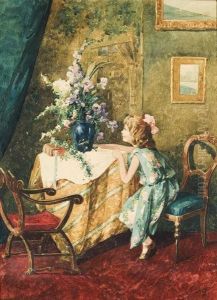Kacz Endrene Komaromi Paintings
Kács Endréné Komáromi was a Hungarian textile artist, renowned for her tapestries and her role in the renaissance of textile art in Hungary during the 20th century. Born in 1924, her full name was Endréné Kács Komáromi but she is commonly referred to by her artist's name, which takes the traditional Hungarian format of using the husband's name with the suffix 'né' to indicate 'wife of.'
Komáromi's work was characterized by a profound understanding of materials and a unique aesthetic that blended traditional craftsmanship with modern artistic expression. She was part of a generation of artists who emerged in the post-World War II era, seeking new forms of expression and exploring the boundaries of various art forms.
She studied at the Hungarian College of Applied Arts, where she honed her skills in textile design and production. Her education equipped her with a deep knowledge of both traditional and contemporary textile techniques, which she would later apply to her own creative practice. Komáromi's art often drew upon historical motifs and folklore, reimagining them in a contemporary context.
Throughout her career, Komáromi played an instrumental role in elevating the status of textile art, which had often been relegated to the realm of craft rather than fine art. Her tapestries and textile works were celebrated for their intricate detail, rich textures, and vibrant use of color. She had a talent for transforming yarn and fabric into complex, evocative images that resonated with both national identity and universal human experiences.
Kács Endréné Komáromi's legacy is one of innovation and inspiration in the field of textile art. She exhibited her work widely, both in Hungary and internationally, and her pieces are included in numerous public and private collections. Her contributions helped pave the way for future generations of textile artists in Hungary and beyond.
Kács Endréné Komáromi passed away in 2008, leaving behind a rich tapestry of artistic achievements that continue to influence and inspire. Her dedication to her craft and her impact on the Hungarian art scene ensure that she remains a respected and celebrated figure in the history of textile art.
